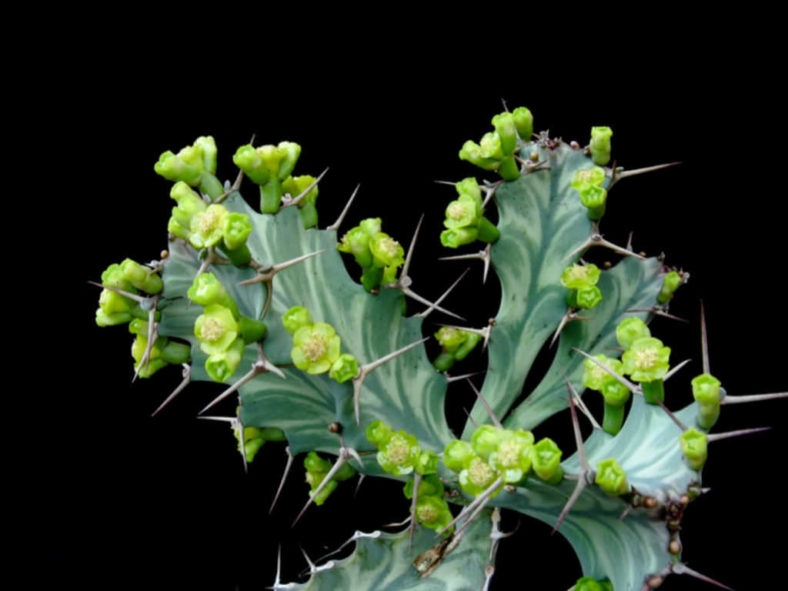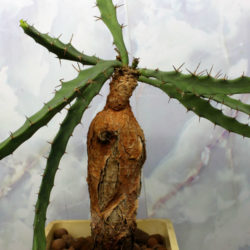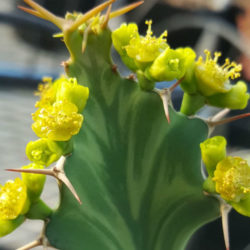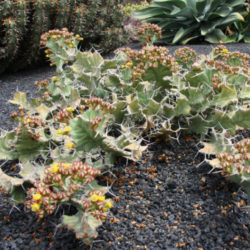Scientific Name
Euphorbia buruana Pax
Scientific Classification
Family: Euphorbiaceae
Subfamily: Euphorbioideae
Tribe: Euphorbieae
Subtribe: Euphorbiinae
Genus: Euphorbia
Description
Euphorbia buruana is a small succulent with a large tuberous root and numerous weakly erect or often semi-prostrate, grey-green branches with conspicuous oblique paler streaks. The tuberous root can reach up to 4 inches (10 cm) in diameter and may be exposed as a caudex. The branches are simple or occasionally rebranched, with usually three (rarely four) wing-like angles, and can grow up to 20 inches (50 cm) long and 1.6 inches (4 cm) thick. The angles are toothed with irregularly spaced teeth. The leaves are rudimentary, scale-like, soon deciduous, and only at the top of the new branch. The spine shields are narrowly oblong, each bearing a pair of unequal spines measuring up to 0.8 inches (2 cm) long.
The cyathia have all parts yellow and appear from winter to summer. The fruits are sharply 3-lobed capsules that are green and flushed with red along the sutures.
Origin
Euphorbia buruana is native to Kenya and Tanzania. It grows in sandy soils amongst grass in open woodland at elevations from 1,970 to 3,610 feet (600 to 1,100 m).

Hardiness
USDA hardiness zone 9a to 11b: from 20 °F (−6.7 °C) to 50 °F (+10 °C).
How to Grow and Care
Euphorbias are very easy to care for. They require a little pampering to become established, but once they are, they are self-sufficient. In fact, more die from too much care and watering than from neglect. Euphorbias need well-draining soil and lots of sunlight. They are not particular about soil pH but cannot tolerate wet soil. Unlike most succulents, Euphorbia does not handle long periods of drought well. It may need weekly watering during the summer. Water whenever the soil is dry several inches below the surface. Water deeply, but don't let them sit in wet soil, which can cause root rot. Add some organic matter or fertilizer to the planting hole. Feed with a half-strength fertilizer monthly if you are growing them in containers or your soil is poor.
Euphorbia can be grown from seed, but they can be difficult to germinate (or even find). It is usually propagated by cuttings. This can be tricky because of the exuding sap. Rooting hormone is recommended with Euphorbias. They tend to grow problem-free, but there are a few pests and diseases to be alert for.
See more at How to Grow and Care for Euphorbia.
Links
- Back to genus Euphorbia
- Succupedia: Browse succulents by Scientific Name, Common Name, Genus, Family, USDA Hardiness Zone, Origin, or cacti by Genus
Photo Gallery
Click on a photo to see a larger version.


